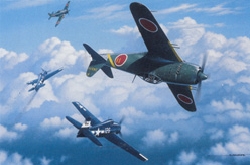|
|
| Lance of the Samurai |
|
 |

|
 |
|
|
| DESCRIPTION |
 |
| 16 x 11.5 Inch Collector Size Unframed Lithograph $40.00
As the war in the Pacific continued to intensify in 1943 and 1944 the naval air forces of Japan began to suffer from both quantitative and qualitative shortcomings in both aircraft and pilots that contributed to American domination of the air. The once dominant Japanese naval air arm was decimated in the Battle of the Philippine Sea the defense of the Philippines and other lesser battles. With American bombing forces now capable of reaching the Japanese islands with B-29 Superfortresses the Japanese lacked any effective fighter defenses. In an effort to improve the situation and provide some semblance of air superiority Captain Minoru Genda the architect of the air operations for the attack on Pearl Harbor formed a new elite fighter air group the 343rd Kokutai at Matsuyama in December of 1944. This group contained the best of Japan's remaining fighter pilots which were personally selected for participation. Consisting of three squadrons the 301st 407th and 701st hikotai this fighter unit was Japan's most proficient during the latter months of the war. The effectiveness of this unit was not solely attributable to the skill of its pilots but also resulted from the aircraft which it flew. All three squadrons were equipped with the Kawanishi N1K2-J Shiden-kai ("violet lightning") model 21 fighter. These were fast highly maneuverable and heavily armed fighters. Unlike most earlier Japanese designs these aircraft also provided better armor protection for the pilot. Nicknamed the "George" by the Allies the N1K2-J was derived from an earlier float plane the N1K1 Kyofu. Entering service in late 1944 the George was capable of 365-MPH armed with its four 20-mm wing mounted cannon. In the hands of experienced combat pilots the N1K2-J was the equal to the American-made Hellcats and Corsairs it faced and was vastly superior to the aging Mitsubishi A6M5 Zero. About 400 N1K2-Js would be produced before the end of the war. The efficacy of Genda's idea was demonstrated on March 19 1945 when fifty-four aircraft from the 343rd attacked an unsuspecting and overconfident carrier strike group of F6Fs F4Us and SB2-Cs in the Kure area. In a matter of minutes the American force was shredded by Genda's elite group. The Japanese claimed the destruction of forty-eight U.S. fighters and four dive bombers vs. the loss of only sixteen of its own aircraft. On June 2 1945 a force of twenty-one N1K2-Js attacked a similarly-sized force of Corsairs. In this battle the Japanese claimed 18 victories. It was estimated that during the six month period in which the 343rd operated that a total of 170 American aircraft were downed compared to the loss of 74 Japanese pilots. Pictured in Stan Stokes painting entitled Lance of the Samurai is the Shiden-kai flown by Chief Petty Officer Shoichi Sugita of the 301st hikotai. During the March 19th combat Sugita claimed four F6Fs and three probables. He was later killed in action on April 15 1945. |
|


|